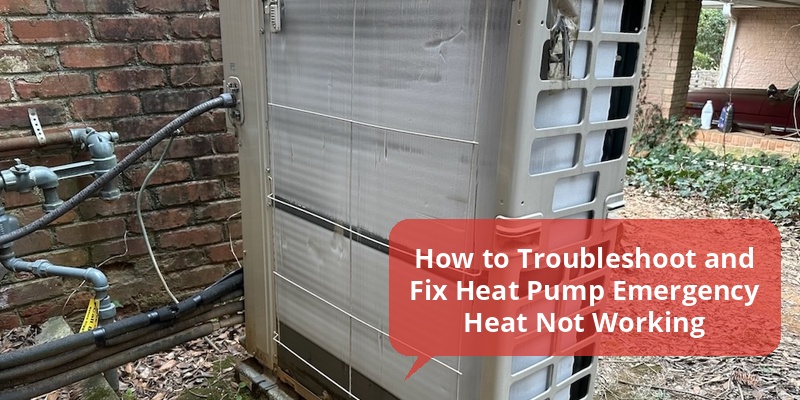When the emergency heat on a heat pump is not working, it can leave your home cold during freezing weather. Emergency heat provides supplemental warmth when the primary heat pump cannot maintain the desired temperature, especially in extreme cold conditions. Understanding why emergency heat fails and how to troubleshoot it is essential for homeowners relying on heat pumps for efficient heating.
| Common Causes | Troubleshooting Steps | Potential Solutions |
|---|---|---|
| Thermostat Settings Incorrect | Check thermostat mode and temperature | Reconfigure thermostat to emergency heat mode |
| Dirty or Faulty Air Filters | Inspect and replace filters if needed | Replace with clean air filters |
| Electrical Issues | Examine breakers and wiring | Reset breakers or repair wiring faults |
| Malfunctioning Heat Strip | Test heat strips with a multimeter | Replace damaged heat strips |
| Defrost Control Problems | Check defrost cycle operation | Repair or replace defrost control board |
What Is Emergency Heat on a Heat Pump?
Heat pumps transfer heat between indoor and outdoor air, using less energy than conventional heating. Emergency heat, also called auxiliary heat, activates when the heat pump’s ability to warm your home is compromised. It usually consists of electric resistance heating strips inside the indoor unit, which provide direct heat. This mode is essential in extremely low temperatures or if the primary heat pump system malfunctions.
Common Reasons Why Heat Pump Emergency Heat Is Not Working
Several factors may prevent emergency heat from functioning properly, and identifying the root cause helps in effective repair or replacement. Common issues include:
- Incorrect thermostat settings: If the thermostat is not set to emergency or auxiliary heat mode, the heat strips won’t activate.
- Dirty or clogged air filters: Restricted airflow can cause overheating and automatic shutdown of heat strips.
- Electrical problems: Tripped circuit breakers or blown fuses can cut power to the heating elements.
- Faulty heat strips: Electrically damaged or burned out heating elements fail to produce heat.
- Defrost system malfunctions: Problems with the defrost controls can prevent the heat pump from engaging emergency heat when needed.
How to Troubleshoot Heat Pump Emergency Heat Not Working
Proper troubleshooting involves a systematic approach and safety precautions. Turn off power to the heat pump before inspecting electrical components.
1. Verify Thermostat Settings
Ensure the thermostat is in emergency heat mode rather than the regular heat pump mode. Set the thermostat temperature higher than the current room temperature to trigger emergency heat. Some digital thermostats have a dedicated emergency heat button, so consult your thermostat manual for exact instructions.
2. Inspect Air Filters
Dirty air filters reduce airflow and can cause the emergency heat to shut off. Remove the filter and check for dust buildup. Replace filters every 1-3 months depending on usage.
3. Check Electrical Power
Look for tripped circuit breakers or blown fuses related to the heat pump system. Reset breakers if necessary and inspect wiring connections for loose or burnt wires. Electrical problems often cause emergency heat failure.
4. Test Heating Elements (Heat Strips)
Using a multimeter, test the continuity of the heat strips inside the indoor unit. Heat strips with no continuity are defective and should be replaced by a professional HVAC technician.
5. Examine Defrost Control
The defrost control board manages when emergency heat cycles on during defrost periods. If your unit fails to enter emergency heat during frost buildup, the defrost control might be faulty. Troubleshooting this often requires specialized equipment and expertise.
When to Call a Professional HVAC Technician
While some troubleshooting can be performed by homeowners, complex electrical repairs and component replacements should be left to certified HVAC professionals. If after checking settings, filters, and power issues the emergency heat still fails, scheduling a professional diagnosis is recommended.
Certified technicians can safely test and replace heat strips, defrost controls, and resolve wiring problems to ensure your heat pump emergency heat functions reliably throughout the season.
Preventive Maintenance for Reliable Emergency Heat Operation
Regular maintenance can minimize emergency heat failures and extend the life of your heat pump system. Key maintenance tips include:
- Replace air filters regularly to maintain proper airflow and system efficiency.
- Schedule annual HVAC inspections to detect wear and tear on electrical components early.
- Clean indoor and outdoor coil units to optimize heat exchange and reduce system strain.
- Test your emergency heat annually before cold weather arrives to confirm it activates properly.
Understanding the Costs Involved in Heat Pump Emergency Heat Repairs
The cost to repair or replace emergency heat components depends on the issue’s severity and part replaced:
| Repair Type | Estimated Cost Range |
|---|---|
| Thermostat Adjustment | Free to $100 |
| Air Filter Replacement | $20 – $50 per filter |
| Electrical Repairs | $100 – $300 |
| Heat Strip Replacement | $200 – $600 |
| Defrost Control Board Replacement | $250 – $700 |
Investing in preventive maintenance reduces unexpected emergency heat failures and costly repairs.
How to Use Emergency Heat Efficiently to Save Energy
Emergency heat consumes more electricity than standard heat pump operation, so prudent use saves money.
- Use emergency heat only when necessary, such as during extreme outdoor temperatures or when the heat pump fails.
- Avoid setting the thermostat excessively high, which increases energy use.
- Insulate your home well to reduce reliance on emergency heat.
Proper thermostat programming and home insulation can optimize comfort while preventing unnecessary energy bills.
